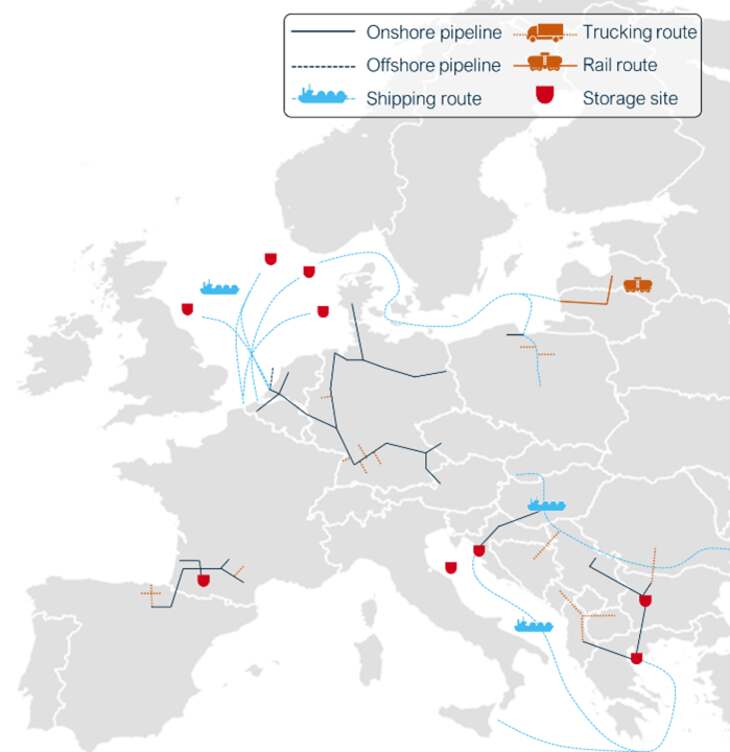This article was written for Euractiv
CCS and CCU require CO2 transport. While shipping and trucking CO2 can grow organically, pipelines require network planning, starting from CCS needs. This will give industry access to geological storage and producers of synthetic fuels access to (renewable) CO2 sources.

Figure 1. Emerging regional CO2 networks based on planned projects, plus indicative trucking routes
Ships, pipelines and trucks will all be needed to transport CO2
EU legislators currently discuss a Commission proposal to create geological CO2-storage capacity to store 50 million tonnes of CO2 per year. By 2050, the need for CCS may grow to 550 Mtonnes/year, which would mean that 15% of current EU greenhouse gas emissions would be captured and stored below-ground. CO2 will need to be captured and stored but also be used to address two main challenges in Europe’s climate action: getting rid of hard-to-abate emissions in industry, aviation and maritime sectors and creating negative emissions to compensate for remaining emissions. Efforts to create storage capacity are well underway, especially in the North Sea region, yet also in other parts of Europe. Synfuel projects are also being developed across the EU. CO2 transport is needed to give industry access to geological storage and to give producers of synthetic fuels access to sources of CO2.
Concentrated emission sources and suitable storage sites are relatively well known already today, therefore CO2 transport planning can best start on the basis of what is needed for CCS. This will also give clarity to suppliers and users of CO2 for synfuel production on where they can best locate their facilities.
Transport solutions will be (combinations of) ship, truck and pipeline transport with terminals where various options come together. Technically, the transport options already exist. Equinor recently ordered two vessels for its Northern Lights project. CO2-pipelines also exist, today some 9,500 km globally, mostly for local transport to industrial CO2 users. Shipping and trucking require limited capital investments and can be scaled up organically to meet a growing demand for transport. Shipping and trucking of liquid CO2 has relatively low operating costs compared to shipping or trucking of hydrogen or LNG because liquefaction of CO2 has less demanding temperature requirements. Liquefying CO2 requires a pressure of 7 up to 45 bar with corresponding temperatures of -52°C up to -10 °C, while LNG is transported at -162°C and hydrogen -250 °C at atmospheric pressure (1 bar). Unsurprisingly, most of the CCUS projects that recently obtained Project of Common Interest (PCI) status rely on ship-transport. Nevertheless, it seems obvious that there will be a need for pipelines too, in particular in areas without good shipping links and where repurposing existing gas pipelines is cost-effective.
Pipelines for CO2 transport require relatively high upfront capital costs, yet can provide cheaper transport of larger volumes. Existing gas pipelines could be repurposed for CO2-transport, especially when transporting CO2 in gaseous form. Transport in gaseous form requires a pressure of 20-40 bar which can be handled by existing gas pipes, while transport of larger volumes in liquid or dense phase requires high pressures of 80-200 bar, making it more challenging to use existing overland gas pipes. However, existing subsea pipelines may be suitable for reconversion to enable CO2-transport.
Large industrial sources of fossil CO2 that would require CCS and large storage locations can be identified relatively easily, while the locations for large-scale synfuel production are mostly unknown today. For both CCS and CCU, shipping and trucking logistics could be scaled up organically and do not require much central planning. Yet it seems obvious that pipelines will be needed in areas without suitable low-cost shipping options. And when pipelines come in, timely coordinated planning will be essential. The urgency (following the revised EU ETS) to achieve net-zero emissions in industry by 2040 means that clarity will be needed soon on where pipeline routes will be needed. Clarity on the topology of CO2 pipelines would also give clarity to suppliers of biogenic CO2 (e.g. from biomethane production) and producers of synthetic fuels on where to locate their facilities. Additional to this, synfuel producers or large suppliers of biogenic CO2 (e.g., pulp and paper plants) could request pipelines to connect them to CO2 backbones or shipping terminals.
Regional rather than pan-European infrastructure
Different to hydrogen, CO2 pipeline infrastructure would not necessarily need to be a pan-EU network that interconnects all parts of Europe. Storage infrastructure should be more or less equally accessible for industries across the EU to ensure a level playing field, which requires the development of storage locations not just in the North Sea region but also in the Baltics, South-West and South-Eastern Europe, plus transport options to connect to those regional storage locations. This may result in regional transport infrastructures with a radius of up to around 1,000 km around storage locations.
Plan needed to piece the options together, starting with the transport needs for CCS
Given the urgency to provide the option of CCS to hard-to-abate industry, in particular the cement industry, the development of CO2-transport cannot be left to energy and logistical companies alone but requires involvement of gas TSOs, Member States and the European Commission. The recent CCUS Forum acknowledged the need for CO2 transport planning and created a working group for it. This is an important first step because it allows energy and logistical companies, gas TSOs and governments to start a joint analysis and planning process. We look forward to seeing the results.
Shape common futures together with us
Get in contact